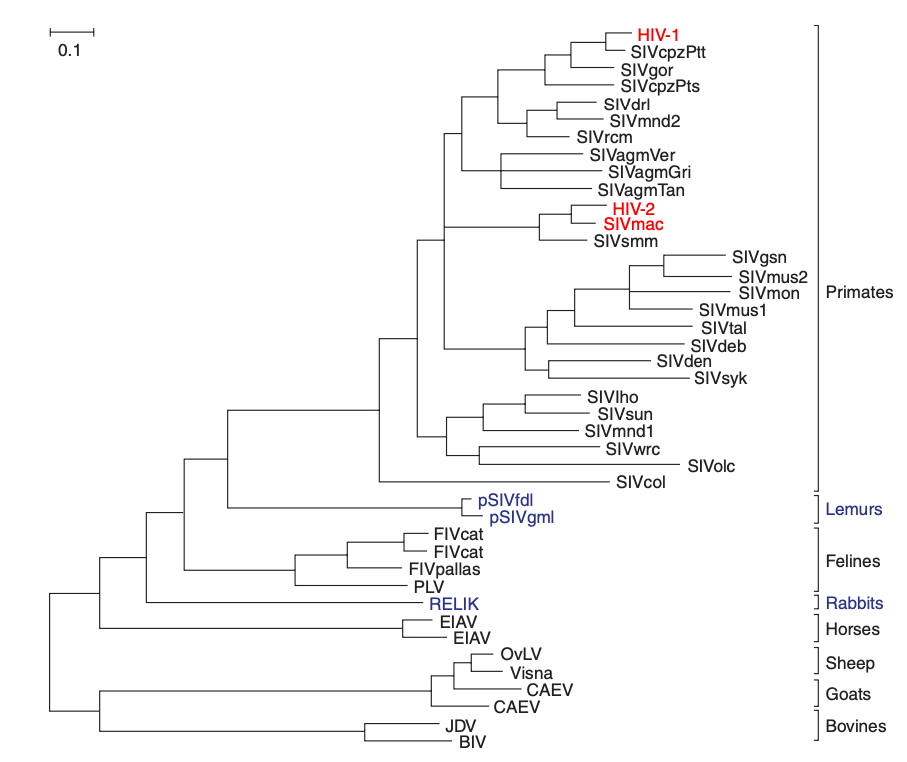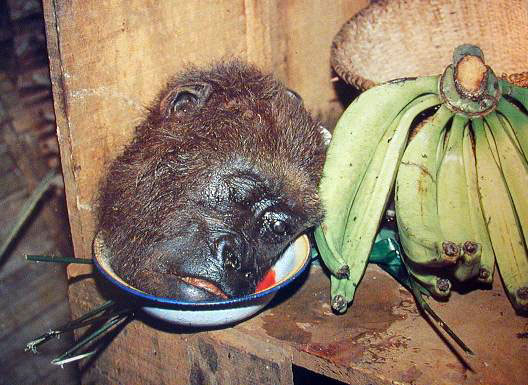This is a fascinating paper that discusses the origin of HIV viruses. In 1981, several homosexual young men died in a mysterious disease. They had rare opportunistic infections caused by apparently harmless bacteria. Later, this virus was named HIV or Human Immunodeficiency Virus and the disease was recognized as Acquired Immune Deficiency Syndrome or AIDS. In 1986 morphologically similar but antigenically different viruses isolated from other AIDS patients in Africa. A later study found that these viruses are genetically very similar to a simian immunodeficiency virus (SIV) causing immunodeficiency disease in the captive macaque.
Later scientists searched for SIVs in other primates coming from Africa. They found that African Primates harbor SIV viruses which are non-pathogenic to the hosts. However, phylogenetically HIV virus is very similar to this SIVs but pathogenic to humans. Later scientists figured out that some SIVs crossed the species boundary from monkey to human several times causing the origin of HIV. HIV is not a single virus – they are a collection of similar viral strains. There are two big classes: HIV-1 and HIV-2. HIV-1 virus is are similar to SIV in chimpanzees and is HIV-2 virus is very close to the SIV virus in sooty mangabey.
If SIVs (mostly) non-pathogenic to non-human primates, what about the macaques: why they develop AIDS because of SIV infection? SIV is not natural in macaques hosts as they are Asian primates. SIVs are only found in African African monkeys or primates.

Primate Lentiviruses
On primate, HIV and SIV they came from a big family of viruses which is called lentiviruses. This lentivirus can cause chronic persistent infection in mammals. A small proportion of them even became endogenous. That means they can attach their DNA to the host germline genome and can be vertically transmitted from mother to child. You can find the viral-sequences in the genome of the organism and they are called viral fossils. So far SIV viruses are only found in African primates. And that leads to the belief that SIV emerged after African and Asian old world monkey lineage diverged about 6 to 10 million years ago. Data collected from 40 different primate species shows they have natural SIV infection. Most of the time these species harbor only a single type of SIV virus. However, there are also reports of cross-species infection. Sometimes SIV viruses can make a jump to a different species of primates. Often, that is a dead-end for that virus. Other times, they transmit among the new species members. We also see mosaic strains caused by genome recombination. This is the case when a single individual is infected by two different SIV viruses and there has been a recombination event between two different viral genome. This causes a mosaic genome.

The origin of SIV in Chimpanzee
Phylogenetic analysis shows that SIV from chimpanzees is very close to HIV-1. Chimpanzee forms two species: common chimpanzee and bonobos. If we analyze the mitochondrial DNA of common chimpanzees, there are four subspecies. These are geographically divided subspecies: Western, Nigeria-Cameroon, Central African, and Eastern Africa. Scientists have tracked the SIV distribution in the fecal samples of chimps to characterize viral RNA and done reverse transcriptase PCR. It turns out only two of these subspecies harbor the SIV viruses: one in Central African and the other in Eastern Africa. And if two out of four subspecies show the partial acquisition pattern of SIV, that indicates that the SIV acquisition into Chimpanzee as a host is a very recent event. And interestingly the SIVs is in these two groups of chimpanzees are mosaics, i.e. they are coming from two different lineages SIVs. The 5’ genome, nif and 3’-LTR are coming from red-capped mangabeys and other parts of the genome (vpu, tat, rve, int) are coming fromi mona monkeys. We know that chimpanzees kill and hunt other mammals including different small monkeys. So they can acquire SIV via predation. Gorilla got it in from of sympatric chimpanzees too.

How SIV crossed species boundary and become HIV
There is a practice called bushmeat hunting in different parts of Africa where people kill exotic mammals including chimpanzees and other non-human primates. Scientists believe that sometimes at the beginning of the last century, SIV crossed species boundary from chimpanzee through blood or exposed mucosal surfaces into humans and adapted into the new human-host becoming HIV-1. For HIV-2, similar things happened from sooty mangabey. In Africa, sooty mangabey is killed as agricultural pests as well. Around 1910-1930, parts of central Africa were foreign colony and new cities were flourishing. The HIV-1 pandemic has been traced using phylogenetics and epidemiology into a city of Leopoldville (Belgian colony in Congo, now Kinshasa) where the early epidemic spread. It is there where HIV-1 evolved into different strains before becoming a world pandemic.
Read the paper if this interests you!
Source: Sharp, Paul M., and Beatrice H. Hahn. “Origins of HIV and the AIDS pandemic.” Cold Spring Harbor perspectives in medicine 1.1 (2011): a006841.



Leave a Reply